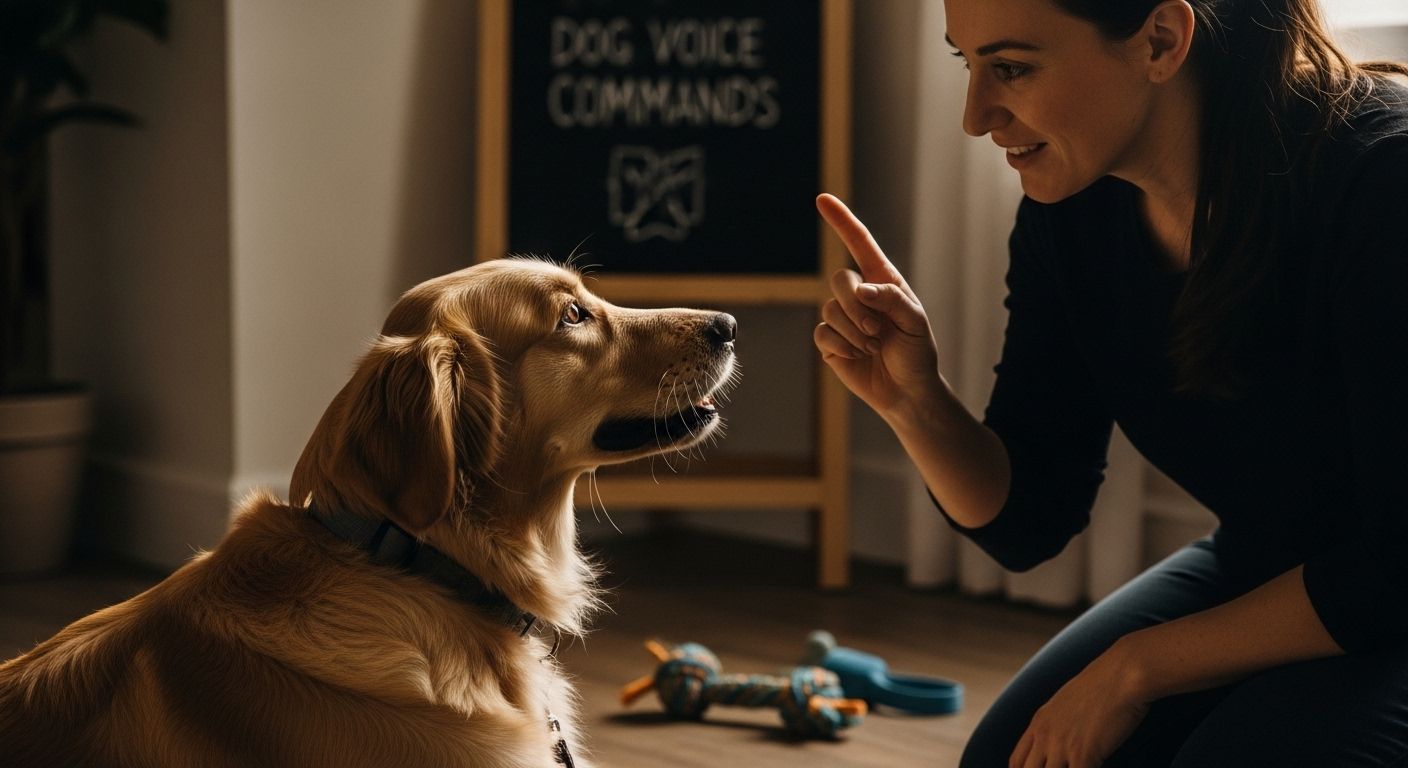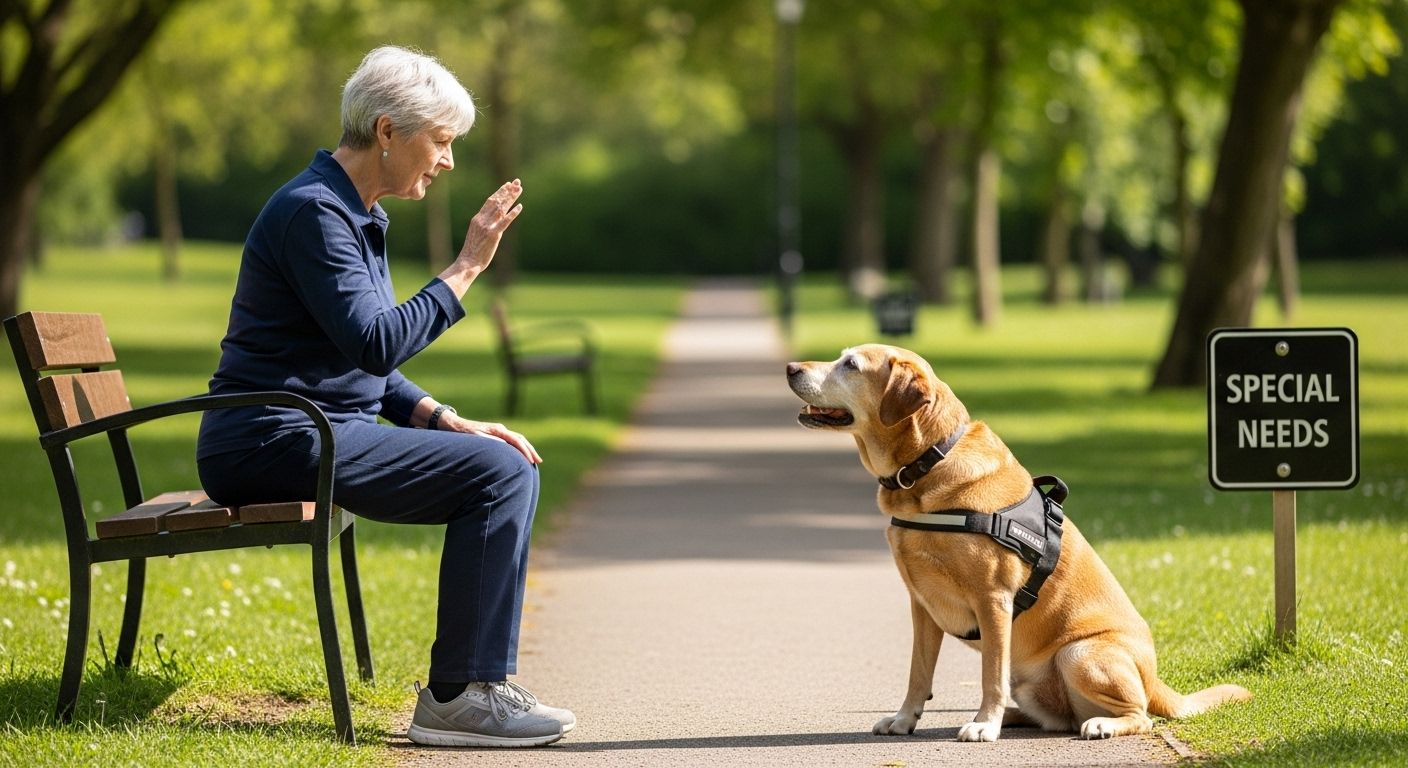
Training your dog to respond to voice commands can be life changing. Studies show that dogs are most responsive to commands from their own owners, with success rates as high as 80 percent when clear and consistent cues are used. Most people think voice commands are just about obedience, but that is only part of the story. The bigger impact is the unbreakable trust and true connection you build each time your dog actually understands what you mean.
Table of Contents
- Understanding Dog Voice Commands And Their Benefits
- Top Essential Dog Voice Commands Explained
- How To Train Your Dog Using Voice Commands
- Helpful Tips For Special Needs And Senior Dogs
Quick Summary
| Takeaway | Explanation |
|---|---|
| Use clear, consistent commands | Consistent verbal cues establish a common language between you and your dog, enhancing communication and understanding. |
| Positive reinforcement is essential | Rewarding your dog with treats and praise enhances learning and helps build a trusting relationship. |
| Different dogs learn in unique ways | Understanding your dog’s learning style is crucial for effective training; adjust methods to fit their needs. |
| Practice commands in various environments | Teaching commands in different settings helps your dog generalize the learned behaviors, ensuring reliability. |
| Adapt training for special needs dogs | Modify techniques for hearing-impaired or senior dogs, using visual cues and shorter training sessions to fit their abilities. |

Understanding Dog Voice Commands and Their Benefits
Communicating effectively with your dog goes far beyond simple obedience. Dog voice commands represent a sophisticated language of connection that bridges the gap between human intention and canine understanding. These verbal cues are not just about controlling your pet but creating a deep, meaningful relationship built on mutual trust and communication.
The Science Behind Canine Communication
Dogs have an extraordinary capacity to understand human vocal signals. Research from the University of York revealed a fascinating insight into how dogs process human speech. The study demonstrated that using a high-pitched, emotionally charged tone significantly enhances social bonding and increases a dog’s attention. This “dog-speak” method isn’t just cute baby talk but a scientifically validated communication strategy.
The way humans deliver commands matters critically. Scientific research published in the National Center for Biotechnology Information indicates that dogs are most responsive to commands from their owners. This highlights the importance of voice familiarity and the emotional context behind each verbal instruction. Your tone, pitch, and emotional state all contribute to how effectively your dog understands and responds to voice commands.
Building a Communication Foundation
Successful dog voice commands require more than just memorizing words. They demand consistency, clarity, and an understanding of your dog’s unique learning style. Each dog processes information differently based on breed, personality, and previous training experiences. Some dogs respond better to soft, gentle instructions, while others require a more direct approach.
Consider voice commands as a nuanced language where your vocal inflections serve as grammatical markers. A slight change in tone can transform a command from a suggestion to a clear directive. For instance, a firm “Stay” sounds distinctly different from a questioning “Stay?”. Dogs are remarkably attuned to these subtle vocal variations, making your emotional state and delivery just as important as the words themselves.
Training your dog to understand voice commands is not about dominance but about establishing clear communication pathways. It creates a sense of security for your dog, who wants to understand and please you. By investing time in developing consistent voice commands, you’re essentially creating a shared vocabulary that strengthens your bond.
Learn more about advanced communication techniques in our comprehensive guide on dog training terminology. This resource can help you refine your approach and develop a more nuanced communication strategy with your canine companion.
Remember that patience, repetition, and positive reinforcement are key. Voice commands are a skill both you and your dog will develop together, creating a language unique to your relationship. Each successful command is a small victory in building trust, understanding, and mutual respect.
Top Essential Dog Voice Commands Explained
Mastering essential dog voice commands transforms your relationship with your canine companion from basic interaction to seamless communication. These fundamental commands form the cornerstone of effective dog training, providing structure, safety, and mutual understanding between you and your pet.
Foundation Commands Every Dog Should Know
Every dog training journey begins with core commands that establish basic communication and control. The most critical commands include “Sit,” “Stay,” “Come,” “Down,” and “Leave it.” These aren’t just verbal instructions but essential safety mechanisms that can prevent dangerous situations and provide critical control in unpredictable environments.
Here’s a summary table of the five foundation dog voice commands, their purpose, and their main benefit. This helps clarify why each is essential in training and safety.
| Command | Purpose | Main Benefit |
|---|---|---|
| Sit | Get dog to pause and focus | Controls excitement, gains attention |
| Stay | Hold dog’s position until released | Prevents dangerous movement |
| Come | Recall dog to your side | Ensures safety, critical in emergencies |
| Down | Get dog to lie down and remain calm | Helps in crowded or stressful settings |
| Leave it | Stop dog from grabbing/touching an object | Prevents eating dangerous items |
“Sit” serves as the gateway command. It requires your dog to pause and focus, making it fundamental for impulse control. A well-executed “Sit” command helps manage excitement, prevents jumping, and creates a moment of calm attention. When teaching this command, consistency is key. Your voice should be clear, firm, and accompanied by a hand signal to reinforce the verbal instruction.
“Stay” takes impulse control to the next level. This command can literally save your dog’s life by preventing them from running into traffic or approaching dangerous situations. Professional dog trainers emphasize that “Stay” is more than a stationary command it’s about teaching discipline and trust. Research from professional dog training associations suggests that dogs who master the “Stay” command demonstrate higher levels of obedience and responsiveness.
Advanced Communication Strategies
“Come” is perhaps the most critical recall command. In emergency situations, a reliable “Come” can prevent accidents and ensure your dog’s safety. Professional trainers recommend practicing this command in various environments with increasing levels of distraction. Start in a quiet room, then move to the backyard, and eventually practice in parks or areas with more stimuli.
“Down” is another crucial command that goes beyond physical positioning. It represents submission and creates a calm state for your dog. This command is particularly useful in crowded spaces, during veterinary visits, or when you need your dog to remain calm and controlled.
“Leave it” teaches impulse control and can prevent your dog from consuming harmful substances. Whether it’s a dropped medication, toxic food, or a dangerous object, this command can be a lifesaver. The key is to make the command more rewarding than the object of interest.
For those looking to dive deeper into training techniques, check out our comprehensive guide on teaching basic commands. This resource provides step-by-step instructions for perfecting these essential voice commands.
Remember that every dog learns differently. Patience, positive reinforcement, and consistent practice are more important than perfection. Each dog has a unique learning curve, and the goal is clear communication, not robotic obedience. Celebrate small victories, maintain a positive attitude, and enjoy the process of building a stronger bond with your furry companion.
How to Train Your Dog Using Voice Commands
Training your dog using voice commands is an art that combines patience, consistency, and strategic communication. Successful dog voice command training goes beyond simply repeating words it requires understanding your dog’s learning style, creating a positive training environment, and developing a systematic approach to communication.
Establishing the Right Training Environment
Before diving into specific commands, creating an optimal training environment is crucial. Choose a quiet space with minimal distractions where your dog can focus entirely on you. Short, frequent training sessions are more effective than long, sporadic ones. Aim for 5-10 minute sessions, 2-3 times daily, to maintain your dog’s engagement and prevent mental fatigue.
Positive reinforcement is the cornerstone of effective voice command training. Research published in the Journal of Veterinary Behavior demonstrates that dogs respond significantly better to reward-based training methods. This means using treats, praise, and physical affection to reinforce correct behaviors, rather than punishing mistakes.
Consistency in your vocal tone and physical signals is paramount. Dogs are incredibly perceptive to subtle changes in human communication. Your voice should be clear, firm, and emotionally neutral. Avoid using an angry or overly excited tone, as this can confuse your dog and make learning more difficult.
Progressive Training Techniques
Start with the most basic commands and build complexity gradually. Begin each training session by ensuring your dog is in the right mental state calm, attentive, and willing to engage. Use a consistent marker word like “Yes” or a clicker to signal immediate success when your dog performs the desired action.
When teaching a new command, break it down into small, manageable steps. For instance, when teaching “Stay,” first reward your dog for standing still for a second, then gradually increase the duration. Use a clear, single-word command and pair it with a hand signal to reinforce the verbal instruction.
Timing is critical in voice command training. The reward must come immediately after the correct action to create a clear association between the command, the behavior, and the positive reinforcement. Delayed rewards can confuse your dog and slow down the learning process.
Advanced Training Strategies
As your dog masters basic commands, introduce distractions and practice in varied environments. This helps generalize the learned behaviors and ensures your dog can follow commands in different situations. Start in a controlled indoor environment, then gradually move to more challenging spaces like your backyard, a quiet park, and eventually more stimulating locations.
Our detailed guide on teaching basic commands offers step-by-step strategies to help you refine your training approach and overcome common challenges.
Remember that every dog learns differently. Some dogs might pick up commands quickly, while others require more time and patience. The key is to maintain a positive, supportive attitude and celebrate small victories. Training is not just about obedience it’s about building a strong, communicative relationship with your canine companion.
Most importantly, keep training sessions enjoyable. If you or your dog become frustrated, take a break and return to the training later. Consistent, patient, and positive training will transform voice commands from mere instructions to a nuanced language of mutual understanding and respect.
Helpful Tips for Special Needs and Senior Dogs
Training special needs and senior dogs requires a unique approach that prioritizes patience, adaptability, and compassionate communication. These remarkable canines often face additional challenges that demand specialized training techniques and understanding.
Adapting Training for Hearing-Impaired Dogs
VCA Animal Hospitals recommends a comprehensive approach to training deaf dogs. Visual and tactile communication becomes paramount when auditory signals are limited. Consistent hand signals replace verbal commands, creating a clear and reliable communication system. For instance, a raised flat hand can mean “stay,” while a sweeping motion might indicate “come.”
Touch plays a crucial role in training hearing-impaired dogs. Gentle vibrations or light touches can serve as attention-getting mechanisms. The key is to develop a consistent system of communication that feels natural and comfortable for both dog and owner. Some trainers use specialized vibrating collars to gain a dog’s attention without startling them, providing a gentle way to initiate interaction.
Supporting Senior Dogs in Training
Senior dogs experience unique challenges that require modified training approaches. Cognitive decline, reduced mobility, and sensory changes necessitate a more patient and adaptive training strategy. Start by acknowledging your dog’s physical limitations. Shorter training sessions become crucial, with breaks to prevent fatigue and frustration.
Positive reinforcement becomes even more critical for senior dogs. Use high-value treats that are easy to eat and consider softer rewards that are gentle on aging teeth. Visual cues become increasingly important as hearing may diminish. Combine hand signals with any remaining verbal commands to create a comprehensive communication strategy.
Specialized Communication Techniques
Our comprehensive guide on training dogs with disabilities offers in-depth strategies for addressing unique canine needs. The most successful approach involves understanding your individual dog’s specific challenges and adapting your communication accordingly.
The National Animal Health Foundation emphasizes the importance of patience and consistent positive reinforcement. For dogs with sensory impairments, training is less about perfect obedience and more about creating a sense of security and understanding.
Special needs dogs often require additional emotional support. Pay attention to your dog’s body language and energy levels. Some days will be more challenging than others. Create a training environment that feels safe, comfortable, and free from unnecessary stress. Use soft voices, gentle touches, and plenty of reassurance.
The table below summarizes adjustments for training special needs and senior dogs, highlighting recommended approaches, tools, and training modifications. This can help owners adapt their methods for these unique pets.
| Dog Type | Recommended Communication | Helpful Tools/Approaches | Training Modifications |
|---|---|---|---|
| Hearing-Impaired | Hand signals, touch cues | Hand signals, vibrating collars | Rely on visual/tactile rather than voice |
| Senior | Visual cues, softer voice | Soft treats, short sessions | Shorter, gentler sessions; allow breaks |
| Sensory-Impaired | Adapted cues (e.g. light) | Light-based or custom signals | Adjust cues to needs; extra patience |
Additionally, consider incorporating alternative communication methods. Some owners find success with light-based signals for deaf dogs or modified hand signals for dogs with reduced mobility. The goal is to create a communication system that works uniquely for you and your dog.
Remember that every special needs or senior dog is an individual. What works for one may not work for another. Be prepared to experiment, adjust, and most importantly, approach training with boundless love and patience. These dogs have so much to offer, and with the right approach, you can continue to build a deep, meaningful connection that transcends physical limitations.

Frequently Asked Questions
What are the basic voice commands every dog should learn?
The essential commands every dog should know include ‘Sit’, ‘Stay’, ‘Come’, ‘Down’, and ‘Leave it’. These commands help in establishing communication, controlling behavior, and ensuring safety.
How can I effectively train my dog with voice commands?
Effective training involves consistent verbal cues, positive reinforcement, and creating a quiet training environment. Break commands into steps and reward immediately after your dog performs the desired action to reinforce learning.
What should I do if my dog does not respond to voice commands?
If your dog does not respond, assess their learning style and modify your approach. Use clearer commands, consider distractions in the environment, and ensure consistency in training. Patience and positive reinforcement are key.
How can I adapt training for a senior or hearing-impaired dog?
For senior dogs, use shorter training sessions with gentle rewards. For hearing-impaired dogs, rely on visual and tactile cues instead of verbal commands. Develop a consistent signaling system that suits your dog’s needs.
Bring Your Dog’s Voice Training to the Next Level—Achieve Real Two-Way Communication
If you have put in the hard work to master voice commands with your dog, you already know how life-changing clear communication can be. But for many owners, true peace of mind still feels just out of reach. Your dog knows how to sit and stay, but what happens if they need your help and cannot speak? What about families living alone, with service dogs, or with pets who need an extra way to communicate urgent needs? Even the best-trained dogs have limitations when it comes to letting us know exactly what they want.

Now there is a solution that takes everything you have learned a step further. The iPupPee dog alert device bridges the gap between training and safety, giving your pet the power to press a simple button and send a clear signal for help. It is perfect for homes with disabled individuals, seniors, or any dog owner who wants an extra layer of security. To discover how the iPupPee can enhance your dog’s communication skills and independence, visit the official iPupPee site or explore more tips and resources in their educational blog. This is your chance to offer your dog the ultimate voice—give them the tool to truly be heard today.
Recommended
-
[
25 Essential Dog Training Terms Every Pet Owner Needs in 2025
– iPupPee](https://ipuppee.com/blogs/news/essential-dog-training-terms)
-
[
Dog Signal Training Guide 2025: Teach Your Dog with Hand Signals
– iPupPee](https://ipuppee.com/blogs/news/dog-signal-training-guide-2025)
-
[
How to Teach Your Dog Basic Commands in 2025
– iPupPee](https://ipuppee.com/blogs/news/how-to-teach-dogs-basic-commands)
-
[
How to Train Dog Signaling: Simple Steps for 2025
– iPupPee](https://ipuppee.com/blogs/news/how-to-train-dog-signaling)

